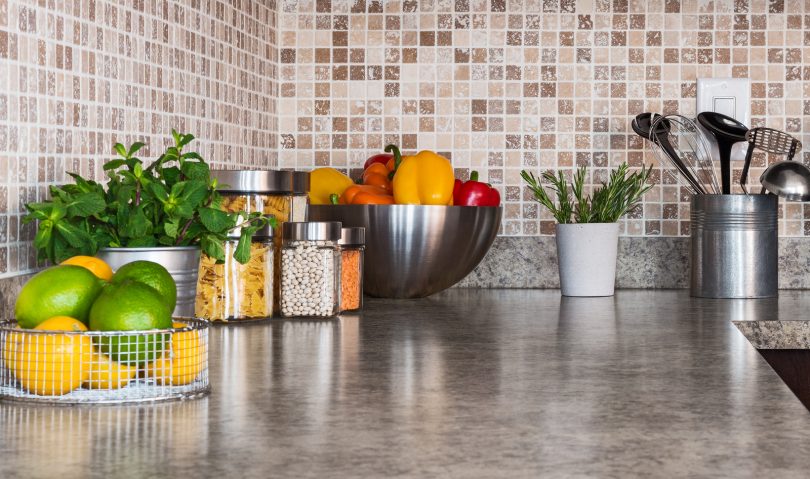Eating healthy starts at home.
It’s a fact that just by cutting out restaurant or fast food meals, you can start seeing a slimmer waistline. But, that’s only if you have a kitchen that’s organized to support your newfound resolve to eat healthy, get strong and have more energy.
Want to get started? Here are eight easy hacks you can do right now, according to Augusta University Health dietitian, Andy Yurechko.
1. Stick to this rule: Out of sight, out of mind.
“It’s easiest just to not have it in your kitchen,” said Yurechko. So if you know you have a weakness for cookies or chocolate—as in, you’ll Cookie-Monster them down in a heartbeat—don’t buy those items.
Too drastic? Then store those items in a cabinet. “Because if you leave them on the table in a candy dish or cookie jar, no matter who it is, if you’re going by, you’re going to reach for one,” said Yurechko.
On the flip side, keep healthy items easily available, say a bowl of fresh fruit, such as apples, pears, oranges and bananas—which will make it more likely for you to grab a healthy snack.
2. Plan ahead.
We get it: When you work and have kids—or if you have other stressors—it can be hard to plan out meals. But if you can carve out some time every weekend to think about the meals you want to cook for the week (say Friday night right after work or before bed), then write out a grocery list (Saturday morning) and shop (Sunday afternoon), we promise it will make your week much less hectic.
Make it fun by writing your week’s “menu” on a chalkboard in your kitchen or on a calendar on the fridge—that way, it’s a good reminder for you, too. And if you can’t get to the grocery store to get everything on the weekend, don’t stress out—just make a second visit midweek. Stay flexible too—maybe you decide you’d rather cook something else or get a last-minute dinner invite. But if you plan ahead, you know you always have a meal that you can cook, which can really ratchet down the stress of making dinner after a long workday.
3. Love your leftovers.
After all, if you’re going to do all the work of making a meal, you might as well make enough to freeze or save for the next day. Extra points if you cook and freeze a bunch of meals over the weekend! Options that tend to freeze well include stews, chilis and casseroles. Keep masking tape and a marker in your kitchen drawer so you can label and date items—believe us, this will keep you from banging your head on the countertop when faced with a dozen vaguely identifiable Tupperware items stacked in your deep freeze.
4. Spice it up.
If you’re like most people, you probably have a cabinet full of spices that you hardly ever use. So why not jazz up your cooking—and cut out the salt—at the same time? Put those spices front and center in your cabinets or display them attractively; keeping them within easy reach. Place salt and other high sodium blends in the back.
5. Install a cookbook shelf.
Whether you buy cookbooks, check them out from the library or store recipes virtually through Pinterest, have a spot where you store new recipes for inspiration. “Once a week, try something new,” said Yurechko, emphasizing colorful foods and even foods from other cultures. A wide variety of foods from different food groups is a great way to enjoy a healthy diet—one that tastes delicious, too.
6. Add sweet flavor with fruit.
Try to make fruit a staple on your grocery list, says Yurechko, who likes to call fruit “nature’s dessert”—but you can enjoy it anytime. For example, he likes to add overripe bananas to his morning oatmeal. “If they’re just a little brown, the natural sugars have intensified,” he said. You can also add fruit to yogurt, pancakes or cereal, savor them alone or with cheese for a European-style “dessert” or even cook it with certain meats (pork with applesauce or chicken curry with raisins and mangos) for unexpected flavor and an extra boost of vitamins.
7. Think fun-size.
When it’s snack time, fruit is always a great choice. But for variety, you can buy proportioned 100-calorie snacks; just make sure to check the labels for whole grain and little to no added sugar. Or better yet, grab a box of Ziplocs or some Tupperware and create your own 100-calorie snacks. Then store them in a designed spot or bin in the fridge or pantry.
Try these easy snack ideas:
- three whole-grain crackers each with a slice of low-fat cheese
- 14 almonds
- 20 pistachios
- six whole-grain pretzel sticks
- eight baby carrots with two tablespoons of hummus
- 25 whole-grain goldfish crackers
- 2 cups popcorn
8. Look into a meal kit service.
While these services can be pricey, said Yurechko, “If you have a busy job and kids, they could be a lifesaver.” A wide variety of services are now available, catering to many different needs, including people who are vegetarian, families needing kid-friendly meals, and more. A meal kit service eliminates the need to grocery shop or meal plan, since fresh ingredients are delivered right to you, and recipes tend to be fairly straightforward. Because you purchase meals based on a certain number of servings, a service can also help you stick to the proper portion size—so long as you’re serving the number of people they suggest. “It can be a great teaching tool to start out with too, especially a new generation growing up that’s cooking less and less,” said Yurechko.
More benefits to a healthy kitchen
By sticking to lean meats and fish, low-fat dairy, fresh fruits and vegetables, and whole grains that you prepare at home, you’ll not only eat healthier, but can save money in the long run. “Lots of fast-food companies suggest that it’s less expensive to buy from them to feed the whole family,” said Yurechko. “But if you price everything out, you’ll see that you can actually make that same meal at home for your family for much less.”
You’ll also get the benefits of teaching your kids how to cook—a skill that’s not as common as it once was. Cooking at home also naturally turns into dining together at the family table, helping to build strong social/familial connections.
Finally, as snooty as it might sound, you’ll likely also end up elevating your palate. Fast food and added sugar won’t taste as good to you (yes, it’s really true!) as your body starts to crave what it really needs to be strong and healthy—right there in your own kitchen.





